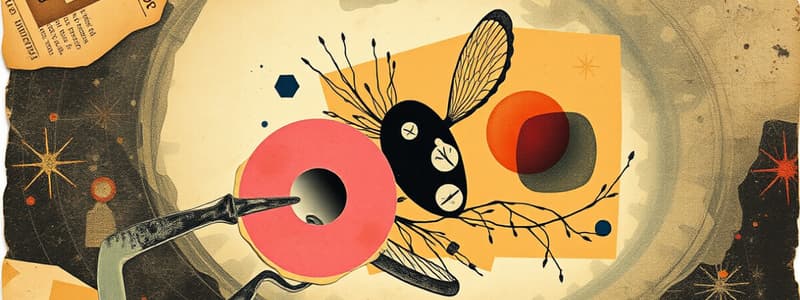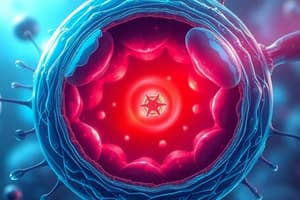Podcast
Questions and Answers
What is the cell membrane made up of?
What is the cell membrane made up of?
Phospholipids bilayer, proteins and cholesterol.
What does the cell membrane do?
What does the cell membrane do?
The cell membrane has a fluid semi-permeable barrier against harmful mutations and is used as a getaway for desired materials.
What is the purpose of the cytoplasm?
What is the purpose of the cytoplasm?
Cytoplasm is a jelly-like substance responsible for supporting the organs and providing nutrients to the cell.
What is the mitochondria and what takes place in it?
What is the mitochondria and what takes place in it?
What is the folded membrane of a mitochondria called?
What is the folded membrane of a mitochondria called?
What takes place in chloroplasts?
What takes place in chloroplasts?
Why do thylakoids stack?
Why do thylakoids stack?
Why do plants have a cell wall?
Why do plants have a cell wall?
What is an enzyme?
What is an enzyme?
What do substrates bind to on the enzyme?
What do substrates bind to on the enzyme?
What are the two types of active sites?
What are the two types of active sites?
What is denaturing?
What is denaturing?
What are inhibitors?
What are inhibitors?
What are competitive inhibitors?
What are competitive inhibitors?
What are non-competitive inhibitors?
What are non-competitive inhibitors?
What is simple diffusion?
What is simple diffusion?
What is facilitated diffusion?
What is facilitated diffusion?
What is osmosis?
What is osmosis?
What is active transport?
What is active transport?
What is cytosis?
What is cytosis?
What is endocytosis?
What is endocytosis?
What is tonicity?
What is tonicity?
What is hypertonic?
What is hypertonic?
What is hypotonic?
What is hypotonic?
What is isotonic?
What is isotonic?
What will happen to an animal and plant cell in a hypertonic solution?
What will happen to an animal and plant cell in a hypertonic solution?
What will happen to an animal and plant cell in a hypotonic solution?
What will happen to an animal and plant cell in a hypotonic solution?
What will happen to an animal and plant cell in an isotonic solution?
What will happen to an animal and plant cell in an isotonic solution?
What is photosynthesis?
What is photosynthesis?
What is the photosynthesis equation?
What is the photosynthesis equation?
Why is light needed for photosynthesis?
Why is light needed for photosynthesis?
What is the light-dependent phase of photosynthesis?
What is the light-dependent phase of photosynthesis?
What is the light-dependent equation?
What is the light-dependent equation?
What is the light-independent phase of photosynthesis?
What is the light-independent phase of photosynthesis?
What increases photosynthesis?
What increases photosynthesis?
What decreases photosynthesis?
What decreases photosynthesis?
What is cellular respiration?
What is cellular respiration?
Flashcards are hidden until you start studying
Study Notes
Cell Membrane Structure and Function
- Composed of a phospholipid bilayer, proteins, and cholesterol.
- Acts as a semi-permeable barrier protecting against harmful mutations and allowing selective passage of materials.
Cytoplasm
- Jelly-like substance supporting organelles and providing nutrients to the cell.
Mitochondria
- Known as the powerhouse of the cell, responsible for cellular respiration.
- Converts glucose into ATP (energy).
- Internal folded membrane called cristae increases surface area for energy production.
Chloroplasts and Photosynthesis
- Site of photosynthesis where light energy is converted into glucose.
- Thylakoids stack into structures called grana to enhance surface area for energy generation.
Plant Cell Wall
- Provides rigid structure and support, compensating for the absence of bones.
Enzymes
- Proteins that act as biological catalysts, speeding up chemical reactions without being consumed.
- Substrates bind to enzymes at the active site.
- Two types of active sites: lock and key model; induced fit model.
Enzyme Denaturation and Inhibition
- Denaturation occurs due to high temperature or pH, altering the active site's shape and functionality irreversibly.
- Inhibitors prevent substrate binding by altering the active site; competitive inhibitors bind to the active site, while non-competitive inhibitors bind elsewhere.
Transport Mechanisms
- Simple Diffusion: Movement of small uncharged molecules from high to low concentration across a membrane.
- Facilitated Diffusion: Movement of large or charged molecules through protein channels from high to low concentration.
- Osmosis: Movement of water from high water potential to low water potential across a semi-permeable membrane.
- Active Transport: Movement against concentration gradient (low to high) using protein pumps.
- Cytosis: Bulk transport of molecules by membrane folding. Includes endocytosis (taking substances into the cell).
Tonicity
- Measurement of solute concentration in relation to the cell's internal environment.
- Hypertonic: Higher solute concentration outside the cell; animal cells shrivel and plant cells become plasmolysed.
- Hypotonic: Higher solute concentration inside the cell; animal cells may burst while plant cells become turgid.
- Isotonic: Equal solute concentration; animal cells remain unchanged, and plant cells become flaccid.
Photosynthesis
- Converts light energy into glucose from water and carbon dioxide.
- Photosynthesis equation: 6CO2 + 6H2O = C6H12O6 + 6O2.
- Light is essential for photosynthesis, absorbed by chlorophyll in chloroplasts, converting light energy into chemical energy.
Photosynthesis Phases
- Light-dependent Phase: Occurs in thylakoids; solar energy splits water to produce oxygen and ATP.
- Light-independent Phase: Occurs in the stroma; uses ATP to convert carbon dioxide and hydrogen into glucose.
Factors Affecting Photosynthesis
- Increases: Higher temperature, light intensity, and CO2 concentration.
- Decreases: Excessively high temperatures, reduced water supply, and unfavourable light wavelengths.
Cellular Respiration
- Process of converting glucose into ATP, storing energy for cellular activities.
Studying That Suits You
Use AI to generate personalized quizzes and flashcards to suit your learning preferences.




